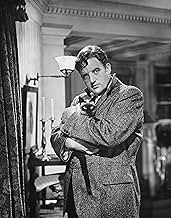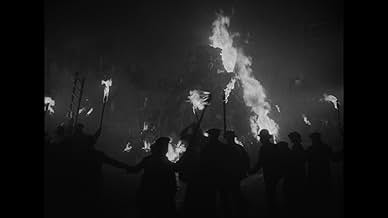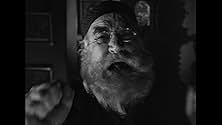CALIFICACIÓN DE IMDb
7.3/10
4.4 k
TU CALIFICACIÓN
Agrega una trama en tu idiomaA promising classical musician finds his life poisoned by a music hall dancer -- and by the strange gaps in his memory.A promising classical musician finds his life poisoned by a music hall dancer -- and by the strange gaps in his memory.A promising classical musician finds his life poisoned by a music hall dancer -- and by the strange gaps in his memory.
- Dirección
- Guionistas
- Elenco
- Premios
- 2 premios ganados en total
Harry Allen
- Pot Man
- (sin créditos)
Radford Allen
- Boy
- (sin créditos)
Jimmy Aubrey
- Drunk
- (sin créditos)
J.W. Austin
- Det. Insp. King
- (sin créditos)
Brandon Beach
- Concertgoer
- (sin créditos)
Wilson Benge
- Waiter
- (sin créditos)
Frank Benson
- Newsman
- (sin créditos)
Arthur Berkeley
- Pub Patron
- (sin créditos)
Ted Billings
- Pub Patron
- (sin créditos)
Lulu Mae Bohrman
- Concertgoer
- (sin créditos)
Clifford Brooke
- Gas Company Watchman
- (sin créditos)
Bob Burns
- Concertgoer
- (sin créditos)
- Dirección
- Guionistas
- Todo el elenco y el equipo
- Producción, taquilla y más en IMDbPro
Opiniones destacadas
Though it's virtually impossible to find a copy of this buried treasure, it's worth a fair bit of digging. (The film is available on tape only, in mediocre print condition, and carried by only a handful of rental stores in the country.) It's not a brilliant film, but it has some virtuoso camera work that one would never expect to find in a filmi of its type. (Watch for the camera shot in the first seconds of the film that swings quickly up from a crowded street, through a window, and into a tight
closeup of the face of a man about to be killed - very impressive.) This is the type of film one can imagine Martin Scorsese taking an interest in - a skillful, craftsmanlike film overlooked by all but a few film buffs. The performances as well, especially Laird Cregar's, are terrific.
closeup of the face of a man about to be killed - very impressive.) This is the type of film one can imagine Martin Scorsese taking an interest in - a skillful, craftsmanlike film overlooked by all but a few film buffs. The performances as well, especially Laird Cregar's, are terrific.
Laird Cregar stars as George Harvey Bone, a turn of the 20th century London composer. He's busy working on a concerto, but gets distracted by a chanteuse named Netta Longdon (Linda Darnell). He gets his heart broken by this self-serving lady, who's only interested in what he can do for her. Meanwhile, he keeps suffering prolonged "episodes" - brought on by loud, discordant noises - and he can't remember what he does or where he goes during these periods. As it turns out, he becomes impulsively murderous.
"Hangover Square", named for the London address at which Bone resides, was scripted by Barre Lyndon, based on a novel by Patrick Hamilton. Sadly, it would turn out to be the final picture for Cregar, who suffered the ill effects of an attempted crash diet. But he certainly goes out in style, creating a vivid character who's far more sympathetic than the character he played for director John Brahm in "The Lodger". While the other cast members are good, this largely remains his show - one that his character sees through to the bitter end.
Darnell and the equally lovely Faye Marlowe are intoxicating as the women in his life. One does feel disgruntled on Bones' behalf when Netta reveals her true colours. George Sanders is his typical classy, dapper self as an analyst working for Scotland Yard. Glenn Langan is amusingly smarmy as Bones' rival for Nettas' affections. And Alan Napier, Michael Dyne, and Frederic Worlock lend able support in various other roles.
While the excellent black & white cinematography by Joseph LaShelle is definitely a key element, the film works best as a marriage of image and music. Bernard Herrmann is one of the most valuable assets that the film can boast, as his lush score & concerto provide the perfect accompaniment for these melodramatic goings-on.
One clever highlight: Bone taking advantage of a fiery Guy Fawkes celebration night.
Eight out of 10.
"Hangover Square", named for the London address at which Bone resides, was scripted by Barre Lyndon, based on a novel by Patrick Hamilton. Sadly, it would turn out to be the final picture for Cregar, who suffered the ill effects of an attempted crash diet. But he certainly goes out in style, creating a vivid character who's far more sympathetic than the character he played for director John Brahm in "The Lodger". While the other cast members are good, this largely remains his show - one that his character sees through to the bitter end.
Darnell and the equally lovely Faye Marlowe are intoxicating as the women in his life. One does feel disgruntled on Bones' behalf when Netta reveals her true colours. George Sanders is his typical classy, dapper self as an analyst working for Scotland Yard. Glenn Langan is amusingly smarmy as Bones' rival for Nettas' affections. And Alan Napier, Michael Dyne, and Frederic Worlock lend able support in various other roles.
While the excellent black & white cinematography by Joseph LaShelle is definitely a key element, the film works best as a marriage of image and music. Bernard Herrmann is one of the most valuable assets that the film can boast, as his lush score & concerto provide the perfect accompaniment for these melodramatic goings-on.
One clever highlight: Bone taking advantage of a fiery Guy Fawkes celebration night.
Eight out of 10.
My parents took me to see this when I was 8 & I had nightmares about it for a month or more - compounded by the knowledge that the lead, the great Laird Cregar died shortly after his appearance in it (of complications from dieting - at age 28!). The total immersion of this film into the clinical madness of a composer who cracks up when he hears discordant sounds & the greed & opportunism of his paramour give it a real nasty Edwardian gothic mood. There are scenes of creepiness here that seem almost the prototypes for Hitchcock classics like Psycho & Vertigo. (Bernard Hermann wrote the composer's scores as well as the background music). But it's also a great exercise on good vs evil, apollo vs dionysius & above all high art vs low art. The 2 main leads, Cregar & Sanders, the director & writer were involved in the making of The Lodger - a Jack the Ripper film - the year before.
HANGOVER SQUARE is one of my favorite films in which LAIRD CREGAR appeared--in fact, his last before a crash diet ruined his health and led to his death at age 28. Seeing him in this film, made me realize what a wonderful Rochester he would have made in '44's JANE EYRE. He had the kind of presence that looms over every frame of this film, even when he's not actually in the scene.
He's a troubled musician who reacts violently when he hears certain discordant sounds. LINDA DARNELL makes an attractive romantic presence in her period costuming (it takes place in Victorian London), and GEORGE SANDERS does a nice job as a doctor (a good guy for a change).
The scenes that stand out are Cregar climbing the ladder of a bonfire to dispose of his latest victim and the finale where he's playing the piano in a deserted building as the flames spread around him--all the while Bernard Herrmann's score is making an impact.
It's a delicious LAIRD CREGAR performance and a fitting finale to his short but illustrious career. It's somewhat similar to a previous film, THE LODGER, another Victorian thriller he did with Merle Oberon.
He's a troubled musician who reacts violently when he hears certain discordant sounds. LINDA DARNELL makes an attractive romantic presence in her period costuming (it takes place in Victorian London), and GEORGE SANDERS does a nice job as a doctor (a good guy for a change).
The scenes that stand out are Cregar climbing the ladder of a bonfire to dispose of his latest victim and the finale where he's playing the piano in a deserted building as the flames spread around him--all the while Bernard Herrmann's score is making an impact.
It's a delicious LAIRD CREGAR performance and a fitting finale to his short but illustrious career. It's somewhat similar to a previous film, THE LODGER, another Victorian thriller he did with Merle Oberon.
Famous Composer George Harvey Bone (Laird Cregar) turns from gentle giant to violent murdering psychopath when prompted by certain sounds - he can then recall nothing. Into his life comes tricky nightclub singer Linda Darnell who uses him to write popular songs that she can use / sell - he becomes bewitched.
Glorious piece of Grand Guignol evoking Jekyll and Hyde and a foggy, chestnut roasting London. The story is well played out and full of memorable scenes without going over the top. At the centre of it all is Cregar, hugely impressive as both a sweet, gentle man and an evil killer. He is well supported by Darnell who is good at being bad and George Sanders as the psychiatrist / amateur detective. Bernard Herrman's score is one of his best and used well throughout, but particularly in the climactic scene which is truly terrific.
Glorious piece of Grand Guignol evoking Jekyll and Hyde and a foggy, chestnut roasting London. The story is well played out and full of memorable scenes without going over the top. At the centre of it all is Cregar, hugely impressive as both a sweet, gentle man and an evil killer. He is well supported by Darnell who is good at being bad and George Sanders as the psychiatrist / amateur detective. Bernard Herrman's score is one of his best and used well throughout, but particularly in the climactic scene which is truly terrific.
¿Sabías que…?
- TriviaIn the book "A Heart at Fire's Center: The Life and Music of Bernard Herrmann," director John Brahm said this about the concerto scene: "For a long time, I had been dissatisfied with the photography of music in films. Musicians themselves are uninteresting; it is what they play that should be photographed. I myself could not read a note of music, but when Herrmann came and saw the finished film he could not believe it. I had photographed his music."
- ErroresThe title of Patrick Hamilton's novel, 'Hangover Square', is a play on words based on 'Hanover Square'. It is not meant to be Bone's actual address as it is in the film version, where a street sign marked 'Hangover Square' is seen.
- Citas
[first title card]
Title Card: This is the story of George Harvey Bone who resided at number 12, Hangover Square, London, S.W. in the early part of the Twentieth Century. The British Catalogue of Music lists him as a Distinguished Composer~~~
- Créditos curiososOpening credits: This is the story of George Harvey Bone who resided at number 12, Hangover Square, London, S.W. in the early part of the Twentieth Century. The British Catalogue of Music lists him as a Distinguished Composer~~~
- ConexionesFeatured in Biography: Linda Darnell: Hollywood's Fallen Angel (1999)
- Bandas sonorasHave You Seen Joe?
(uncredited)
Music by Lionel Newman
Lyrics by Charles Henderson
Performed by Kay St. Germain Wells
[Netta (Linda Darnell) sings the song at the bar hall in her opening performance]
Selecciones populares
Inicia sesión para calificar y agrega a la lista de videos para obtener recomendaciones personalizadas
- How long is Hangover Square?Con tecnología de Alexa
Detalles
Taquilla
- Presupuesto
- USD 1,154,000 (estimado)
- Tiempo de ejecución1 hora 17 minutos
- Color
- Relación de aspecto
- 1.37 : 1
Contribuir a esta página
Sugiere una edición o agrega el contenido que falta

Principales brechas de datos
By what name was Concierto macabro (1945) officially released in India in English?
Responda





























